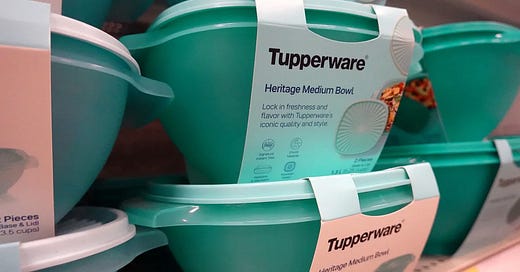Tupperware: A Company as Old as Your Leftovers
Bankruptcy seals the lid on an era in American consumer culture
Tupperware Brands, the company that revolutionized food storage decades ago, has filed for bankruptcy after years of falling popularity and financial troubles. The Orlando, Florida-based company filed for bankruptcy protection on September 17 with $818 million in debt and a plan to sell the company. Declaring Chapter 11 will let the company stay open while it restructures and attempts to turn into a “digital-first, technology-led” company.
The brand experienced explosive growth starting in 1948 with the rise of Tupperware Parties, which became a symbol of empowerment and entrepreneurship for women, while creating a legacy of reliability and innovation that stood the test of time until more recent years.
Tupperware sales growth improved some during the early days of the COVID-19 pandemic, but overall sales have been in steady decline since 2018 due to rising competition along with struggling to stay relevant in an e-commerce dominated world.
Tupperware became a household name synonymous with food storage innovation, but like most popular items – cheaper, similar products started to arrive after the expiration of the Tupperware copyright by the 1980s. Fierce competition in the industry left the brand struggling, with major rivals like Rubbermaid, OXO, and Pyrex rising to challenge it.
Many consumers have also switched to more affordable home storage brands, especially with the growth of online platforms like Temu and retailers like Target expanding their own home storage and kitchenware lines.
The word "Tupperware" is often used to refer to any resealable food container, even if it's not from the Tupperware brand. This is called "genericide," which happens when a brand name becomes so popular that people use it to describe the whole product category.
If a company is the first to bring a product to market (known as the “first-mover advantage”), they have to make sure to keep moving because long-term profitability is not guaranteed. Being first wasn’t enough for Tupperware because it just couldn’t keep pace with an evolving industry.
They ended up stuck in the middle—without modernizing their design and not being the most affordable option.
According to court documents published September 17, 2024, Tupperware currently employs more than 5,450 employees across 41 countries, and partners with a global sales force of more than 465,000 consultants who sell products on a freelance basis in nearly 70 countries. The lenders have consented to allow Tupperware to spend its cash on payroll and other routine expenses until October 11.
Tupperware will return to bankruptcy court on October 11 to request a longer-term court order that allows it to maintain access to its cash accounts.





